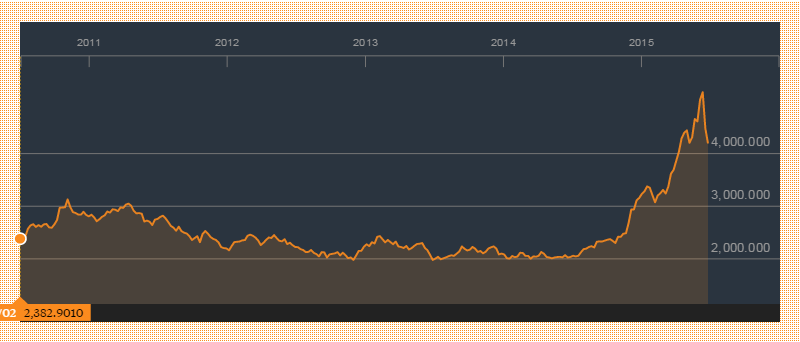Newswires in the forex world may be dominated by headlines on the Greek debt talks these days so I thought y’all should know that the Chinese central bank has been quietly making unprecedented moves. Here’s the lowdown on their latest easing efforts.
Easing, you say? What exactly did they do?
As my buddy Pip Diddy mentioned in his Asian session recap last Thursday, the People’s Bank of China (PBoC) announced that they’d be pumping up liquidity to the tune of 35 billion yuan in order to “stabilize market expectations.” Before financial market participants could even digest what this statement meant, the PBoC followed it up with a 0.25% benchmark interest rate cut, a 0.25% deposit rate cut, and a reduction of 50 basis points on the reserve ratio requirement (RRR).
All in all, these moves have the combined effect of increasing the amount of cash in circulation. If you’re thinking that this isn’t really a big deal, then you should know that this particular PBoC easing combo hasn’t been served since 2008! In addition, these are being compared to former Fed head Alan Greenspan’s stimulus strategies during the U.S. market meltdown back in 1987.
Yikes! Is the Chinese economy on the verge of a meltdown?
A quick look at the long-term chart of the Shanghai Composite Index, which basically shows how the Chinese equity market is faring, indicates a relatively good performance for the past five years.
As you can see from the chart above, the index has more than doubled in value over the past year, reaching record highs earlier this month. This prompted the PBoC to secretly drain funds from the country’s financial system in order to prevent the stock market from overheating and to keep a lid on volatility.
However, analysts say that this surprise move actually caused investors to panic, triggering a 20% decline in the Chinese equity market in the days that followed. The Shanghai Composite Index chalked up a 7.4% tumble on Friday, bringing its value down 18.8% from its June 12 high and leading PBoC officials to panic as well.
Wait a minute. Are Chinese policymakers taking their cues from the stock market and not economic data?
It does seem that way, as the PBoC clarified that their recent easing efforts have been geared at stabilizing the Chinese equity market. Of course you also have to remember that large companies listed in the Chinese stock exchange account for a huge chunk of manufacturing activity, investment, and exports — all of which make a considerable contribution to overall economic growth. While there’s no denying that China’s weakening economic figures warranted central bank stimulus months ago, it does make sense that PBoC officials are being more sensitive to stock market cues.
All right, I’ll bite. So what can this mean for the forex market?
Well, it doesn’t really mean much for the Chinese yuan’s forex levels since the PBoC sets a trading range for its currency. Note that the Chinese central bank set its USD/CNH benchmark midpoint rate slightly lower in response to the U.S. Treasury’s calls for yuan appreciation. However, these PBoC easing moves are likely to limit the currency’s gains and keep it within the central bank’s desired levels.
Increased stimulus in China could have a more pronounced impact on the commodity currencies if the rise in lending and spending in the world’s second largest economy translates to higher demand for raw materials. A pickup in business activity in China could mean rising volumes of iron ore imports from Australia and a rebound in whole milk powder shipments from New Zealand, which could then lead to better trade figures for both economies and gains for their currencies.
For the record, though, the PBoC has been on an easing spree for the past months, yet their efforts failed to give a strong boost to Chinese growth prospects. They’ve already cut interest rates four times since November 2014 and have announced several reductions in their RRR so far this year, yet these have barely translated to export gains for the commodity-dependent countries. Are the PBoC’s monetary policy tools losing their magic?
Recommended Content
Editors’ Picks
EUR/USD clings to gains above 1.0750 after US data

EUR/USD manages to hold in positive territory above 1.0750 despite retreating from the fresh multi-week high it set above 1.0800 earlier in the day. The US Dollar struggles to find demand following the weaker-than-expected NFP data.
GBP/USD declines below 1.2550 following NFP-inspired upsurge

GBP/USD struggles to preserve its bullish momentum and trades below 1.2550 in the American session. Earlier in the day, the disappointing April jobs report from the US triggered a USD selloff and allowed the pair to reach multi-week highs above 1.2600.
Gold struggles to hold above $2,300 despite falling US yields

Gold stays on the back foot below $2,300 in the American session on Friday. The benchmark 10-year US Treasury bond yield stays in negative territory below 4.6% after weak US data but the improving risk mood doesn't allow XAU/USD to gain traction.
Bitcoin Weekly Forecast: Should you buy BTC here? Premium

Bitcoin (BTC) price shows signs of a potential reversal but lacks confirmation, which has divided the investor community into two – those who are buying the dips and those who are expecting a further correction.
Week ahead – BoE and RBA decisions headline a calm week

Bank of England meets on Thursday, unlikely to signal rate cuts. Reserve Bank of Australia could maintain a higher-for-longer stance. Elsewhere, Bank of Japan releases summary of opinions.
